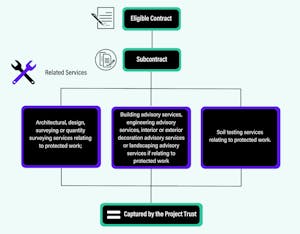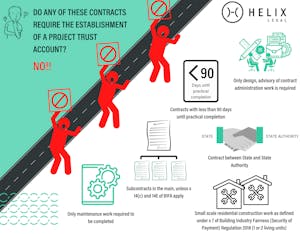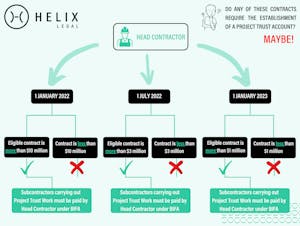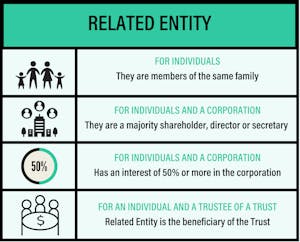Deciding if a Project Trust is needed.
BIFA establishes three very important definitions which scope out the legislative coverage of Trusts, that industry parties need to have a good understanding of, namely Project Trust work, protected work and related services. This will help to answer the question: when is a Project Trust required?
What is Project Trust work?
It includes many types of work that are excluded from the definition of ‘building work’ such as earthmoving and excavating works, electrical works, the erection of scaffolding, and works performed by architects and professional engineers.
What is Protected Work?
Includes ‘Project Trust work’ AND additional work such as:
What are Related Services?
They are specific types of services that, if incorporated in a subcontract to the eligible contract, make the Subcontractor a beneficiary of the Project Trust. The services are:

When is a Project Trust required?
I like to explain this by starting with contracts that are NOT captured by Project Trust requirements.
These are known as exempt contracts.
In other words, the Head Contractor in certain contractual circumstances is not required to establish a Project Trust.

Let me just repeat this very important information.
Contracts, of the type outlined above, do not require the establishment of a Project Trust Account.
Now let’s talk about the contracts that MAY be captured by the Project Trust requirements. Where a facet of ‘Project Trust work’ presents in a contract, the Head Contractor has to turn their mind to determine whether a Project Trust needs to be established.
The question for Head Contractors is:
Will 50% or more of the contract price represent the carrying out of Project Trust work?
Let’s look at the short video above again that explains what is Project Trust work.
If the answer is NO to this key threshold question:
- The Head Contractor is NOT required to establish a Project Trust.
However, if the answer is YES to this question:
- The Head Contractor has other matters to consider relating to the date of the contract and its value.
Well, that is our hope anyway!!

If after this assessment the Head Contractor confirms that a Project Trust is required, then he must proceed to open one. Furthermore, in the circumstances where a Project Trust is required, other Subcontractors doing certain types of ‘non-Project Trust work’ under contract on that project, will also be paid under the Trust requirements.
This is a bit of a head spinner but I will do my best to explain things.
Subcontractors carrying out any type of the more broadly defined ‘Protected Work‘ under a subcontract, will now also enjoy getting paid by the Head Contractor under BIFA.
Let’s again look at a short video above explaining what is protected work.
What is a Related Entity?
Finally, there is currently one situation where a first-tier subcontract is also considered an eligible contract requiring the establishment of a Project Trust: IF the Subcontractor is a related entity of the Head Contractor as defined under Chapter 2, Part 2, s 10A of the Building Industry Fairness (Security of Payment) Act 2017 (Qld) (BIFA).
Let’s carefully go over this.
The Head Contractor enters into a contract with a principal that requires the establishment of a Project Trust. The head contract in turn enters into a subcontract for a portion of the contracted works to be carried by a Subcontractor who is considered a related entity of the Head Contractor.
In this case, the Subcontractor must establish a Project Trust if they in turn ‘sub-subcontract’ all or part of those contracted work.
Some examples of who are considered a related entity are:

Final Thoughts
And that brings us to the end of my Statutory Trusts Series. Thank you to those who have read all 8 articles, I hope you now feel more educated in the area of Statutory Trusts. Please feel free to reach out to our Helix Compliance team at any time; we are here to help with your Trusts questions. Helix is constantly providing resources, free content and education through our articles at Helix Insight, our social media platforms, and our monthly newsletter that you can subscribe to here.
Subscribe to David’s Monthly Trust Wrap Up
David Cahill and our Helix Compliance team are all about providing you with the resources and education to navigate Statutory Trusts. To receive free monthly updates on how Trusts are affecting the industry and any tips on how to prepare, SUBSCRIBE BELOW!



